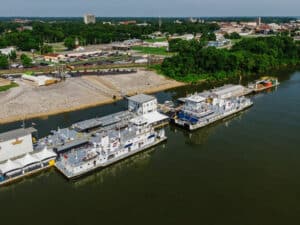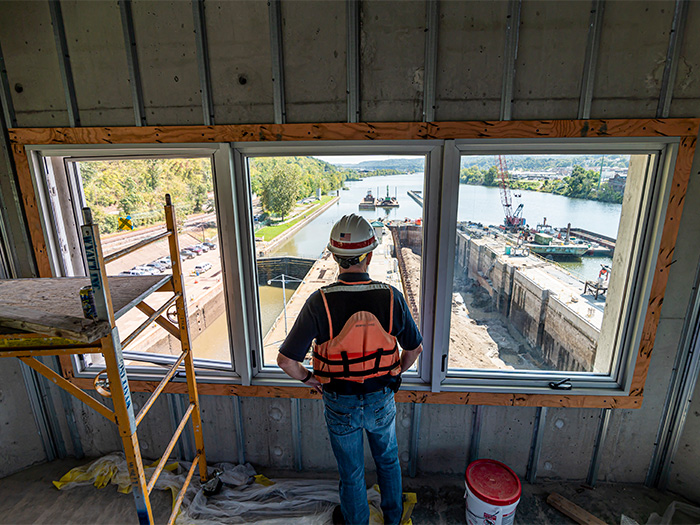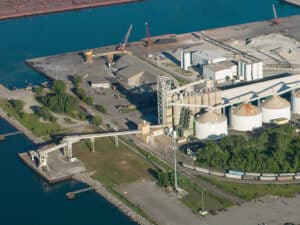
Charleroi Lock and Dam project marks a milestone
Written by Marine Log Staff
Kirk McWilliams, resident engineer for the U.S. Army Corps of Engineers Pittsburgh District, watches construction from the control tower at Charleroi Locks and Dam, located on the lower Monongahela River in Pennsylvania. [U.S. Army Corps of Engineers Pittsburgh District photo by Michel Sauret]
The Pittsburgh Engineer District has marked a major milestone in a $1 billion project that began in 2004: dewatering the the lock chamber at the Charleroi Lock and Dam, the newest navigation lock on the Monongahela River used by inland river shipping traffic. The lock chamber is massive. It can accommodate nine barges and hold 20 million gallons of water, and it is now finally empty.
The Pittsburgh District pumped out so much water from the chamber that it could fill 30 Olympic-sized swimming pools.
“Dewatering the riverside lock chamber is a major turning point in the ongoing construction,” said Kirk McWilliams, the resident engineer with the Pittsburgh District who has been supervising construction at Charleroi Locks and Dam since the beginning.
McWilliams said this construction is part of the much larger Lower Mon Project, which the Corps considers the number one inland navigation priority in the country right now.
The project is significant for the region since both the Monongahela and the Allegheny rivers are critical to continental navigation.
“We’re the headwaters district. That means we’re the headwaters of the whole inland distribution system all the way down to the Gulf of Mexico. It’s very important,” said Shawn Soltis, field engineer at Charleroi.
McWilliams compared this project to motorists finally being able to enjoy a new road or bridge after dealing with years of orange barrels, narrowed lanes, and construction crews.
“Everybody knows about infrastructure,” McWilliams said. “It’s a very relevant topic right now. When you think about infrastructure, you think about highways and bridges. Maybe you think about sewer and water lines. But most people don’t associate navigation locks with infrastructure, and this is as vital to the nation’s economy as highways and bridges.”
Yet, twenty years of construction is an especially long time for a navigation project of this type, McWilliams said. In comparison, a similar construction at Braddock Locks and Dam took only six years, just 30 miles downstream.
The difference is during the Braddock construction, which completed in 2004, the Army Corps had the benefit of a Continuing Contracts Clause. This clause allowed government agencies to award larger, long-term contracts, and pay them yearly, or as funding became available.
When Congress removed that clause, it complicated matters for mega project constructions. Now, the Corps can only contract based on available, annual funding. No longer could the Pittsburgh District award a $200 million contract to a single agency for multiple years of work if the budget was $30 million for that particular project. Instead, it had to break each contract into smaller segments, causing bigger delays. Without this clause, projects became less efficient and more expensive.
“You’ve got redundancy here where you’ve got multiple contractors working on the same feature of work. You’ve got double the cranes. Double the overhead staff. It drives the cost up considerably,” said McWilliams.
After 17 years of middle and river wall lock construction, emptying the chamber marks a shift toward the finish line at Charleroi, he said.
“It’s a large milestone. We’re turning the page on lock wall construction, and we’re getting into putting all the features that go into making this lock operational,” McWilliams said.
With the water pumped out, engineers can begin working on the internals of the chamber, which includes adding the miter gates, the filling and emptying system, culverts, the sills, and new operating equipment.
“The new lock is going to be wider than the old lock. It’s going to remove a bottleneck to navigation. It’s going to allow commercial traffic to lock through Charleroi much faster than it currently does,” McWilliams said.
The chamber measures 720 feet long by 84 feet wide, allowing a commercial tow with nine barges to lock through in 25 minutes instead of two hours. Previously, the two smaller locks at Charleroi were only 56 feet wide, which meant a tow would have to break up its barges and take multiple trips—back and forth—across the chamber to lock through its full cargo.
Once Charleroi is complete, the district will decommission and remove the navigation facility at Elizabeth. Barges will be able to navigate 30 miles nonstop between Charleroi and Braddock, transforming a five-hour navigation stretch into 30 minutes.

![Tom Frazier aground and listing to starboard on Feb. 11, 2024. [Photo: U.S. Coast Guard]](https://www.marinelog.com/wp-content/uploads/2025/06/Towboataground-300x225.jpg)


